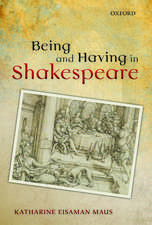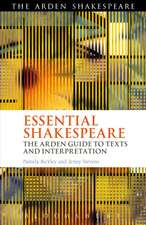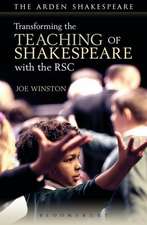Shakespeare and the Apocalypse: Visions of Doom from Early Modern Tragedy to Popular Culture: Continuum Shakespeare Studies
Autor R. M. Christofidesen Limba Engleză Hardback – 13 iun 2012
Drawing on extant examples of medieval imagery, Roger Christofides uses poststructuralist and psychoanalytic accounts of how language works to shed new light on our understanding of Hamlet, Othello, Macbeth, and King Lear. He then links Shakespeare's dependence on his audience to appreciate the allusions made to the religious paintings to the present day. For instance, popular television series like Battlestar Galactica, seminal horror movies such as An American Werewolf in London and Carrie and recent novels like Cormac McCarthy's The Road. All draw on imagery that can be traced directly back to the depictions of the Doom, an indication of the cultural power these vivid imaginings of the end of the world have in Shakespeare's day and now.
Preț: 773.81 lei
Preț vechi: 1112.93 lei
-30% Nou
Puncte Express: 1161
Preț estimativ în valută:
148.07€ • 154.29$ • 122.60£
148.07€ • 154.29$ • 122.60£
Carte tipărită la comandă
Livrare economică 03-17 aprilie
Preluare comenzi: 021 569.72.76
Specificații
ISBN-13: 9781441179944
ISBN-10: 1441179941
Pagini: 240
Ilustrații: black & white illustrations
Dimensiuni: 156 x 234 x 25 mm
Greutate: 0.52 kg
Ediția:New.
Editura: Bloomsbury Publishing
Colecția Continuum
Seria Continuum Shakespeare Studies
Locul publicării:London, United Kingdom
ISBN-10: 1441179941
Pagini: 240
Ilustrații: black & white illustrations
Dimensiuni: 156 x 234 x 25 mm
Greutate: 0.52 kg
Ediția:New.
Editura: Bloomsbury Publishing
Colecția Continuum
Seria Continuum Shakespeare Studies
Locul publicării:London, United Kingdom
Caracteristici
Demonstrates the imagery Shakespeareâ?Ts language draws on can still be seen in popular culture today.
Notă biografică
Roger Christofides is Senior Lecturer at Huddersfield University, UK.
Cuprins
List of Figures \ Preface \ 1. The Reechy Painting and the Old Church Window \ 2. Hamlet and the Living Dead \ 3. Masochistic Damnation in Othello \ 4. Macbeth and the Angels of Doom \ 5. King Lear's Promised End \ 6. Conclusion \ Bibliography \ Index
Recenzii
'This lively and compelling book shows Shakespeare in an entirely new light. Subtly attentive to the language of the tragedies, Roger Christofides captures resemblances between early modern culture and our own, tracing in the dramatist's world and ours some of the most urgent hopes and anxieties.'
'A remarkably graceful exploration of difficult ideas, this refreshing and original study illuminates the connections between English church iconography, Shakespearian tragedy, and our own preoccupation with the end of the world. By showing how the notion of the Apocalypse shapes both language and genre, Mr. Christofides leads us though a subtle and intricate analysis to a genuinely new understanding of four of Shakespeare's greatest plays.'
'Shakespeare and the Apocalypse is a breathtaking read. From its daring opening salvo-that the structure of language itself is apocalyptic-to its surprising ending, the book baffles expectation, constantly taking us to places we've never been in Hamlet, Othello, Macbeth, and King Lear. Using stunning images of "the Doom" gleaned from pre-Reformation art and architecture, Christofides illuminates Shakespeare's darkest tragedies, re-reading them as models of the apocalyptic sensibility that artists, writers, and filmmakers have sought to emulate ever since. Shakespeare and the Apocalypse is rigorously researched and engagingly written; it is essential reading for anyone interested in Shakespeare, popular culture, religious studies, or art history.'
Shakespeare and the Apocalypse will be most useful to readers interested in the intersection between post-structural linguistics and early modern studies...references like the 'The Three Living and the Three Dead' offer a tantalizing glimpse of early modern cultural history.
... an interesting and entertaining read ... it opens up several interesting avenues of exploration into the nature of Shakespearean tragedy. English, theater, and pop-up culture scholars will all find something worthwhile in its pages.
Shakespeare and the Apocalypse by R. M. Cristofides is as much, if not more, about language as it is about images of doom from pre-Reformation England, via Shakespeare, to instances in modern popular culture . . . The book's many references to popular culture . . . are supplementary in both senses. They are additional readings of doom which show how the language of the apocalypse still haunts audiences today . . . Cristofides' contribution, therefore, is important in terms of its informative content and its methodological example.
'A remarkably graceful exploration of difficult ideas, this refreshing and original study illuminates the connections between English church iconography, Shakespearian tragedy, and our own preoccupation with the end of the world. By showing how the notion of the Apocalypse shapes both language and genre, Mr. Christofides leads us though a subtle and intricate analysis to a genuinely new understanding of four of Shakespeare's greatest plays.'
'Shakespeare and the Apocalypse is a breathtaking read. From its daring opening salvo-that the structure of language itself is apocalyptic-to its surprising ending, the book baffles expectation, constantly taking us to places we've never been in Hamlet, Othello, Macbeth, and King Lear. Using stunning images of "the Doom" gleaned from pre-Reformation art and architecture, Christofides illuminates Shakespeare's darkest tragedies, re-reading them as models of the apocalyptic sensibility that artists, writers, and filmmakers have sought to emulate ever since. Shakespeare and the Apocalypse is rigorously researched and engagingly written; it is essential reading for anyone interested in Shakespeare, popular culture, religious studies, or art history.'
Shakespeare and the Apocalypse will be most useful to readers interested in the intersection between post-structural linguistics and early modern studies...references like the 'The Three Living and the Three Dead' offer a tantalizing glimpse of early modern cultural history.
... an interesting and entertaining read ... it opens up several interesting avenues of exploration into the nature of Shakespearean tragedy. English, theater, and pop-up culture scholars will all find something worthwhile in its pages.
Shakespeare and the Apocalypse by R. M. Cristofides is as much, if not more, about language as it is about images of doom from pre-Reformation England, via Shakespeare, to instances in modern popular culture . . . The book's many references to popular culture . . . are supplementary in both senses. They are additional readings of doom which show how the language of the apocalypse still haunts audiences today . . . Cristofides' contribution, therefore, is important in terms of its informative content and its methodological example.


















